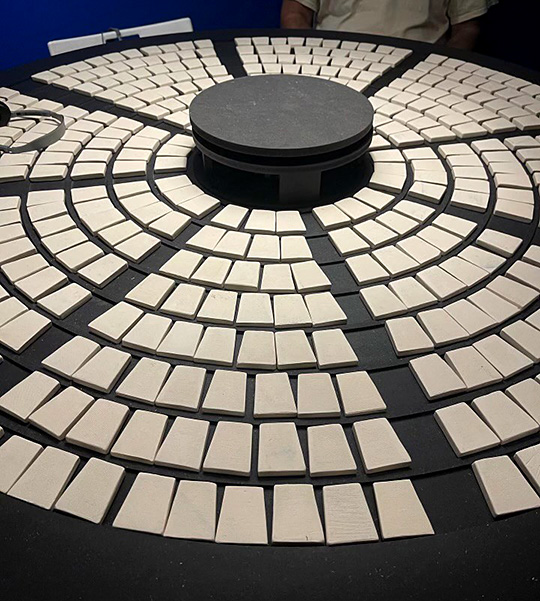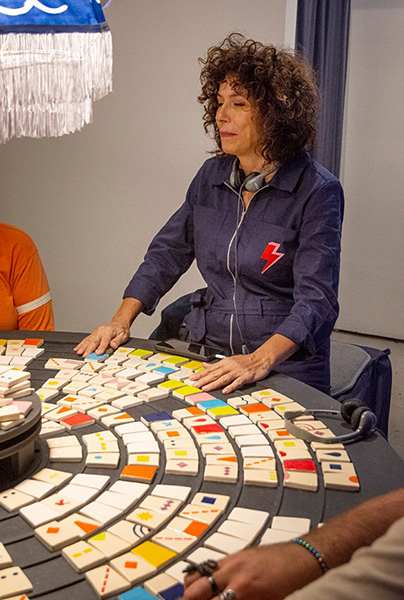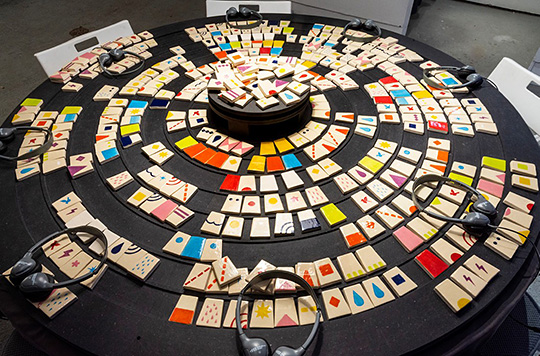 print preview
print previewback GEORGE FERRANDI
we are each other’s atmosphere
Katherine Cooper
What did we lose?
I have been asking myself this question for two years. A dear friend of mine died in February 2020 but we didn’t get to say goodbye or have a funeral for him. Living with this loss and the many other losses that piled up around it in the following years has left me trying to quantify my feelings of grief. How many times did I tell him I loved him? How close were we really? What does his death mean in the context of so many others? How big is my grief compared to yours, compared to hers? How much does it matter? Even if you didn’t lose somebody you knew personally, I bet you’ve asked some of these questions too since early 2020.
I first met George Ferrandi on a week-long vacation I took to an Island in Michigan during the summer of 2022. As somebody who didn’t really have the bandwidth to feel most of my feelings over the course of the pandemic I had not taken a true break–no internet, no family, no work obligation–for about two years. We stayed in a large wooden house on the small island with a number of friends. We shared bathrooms and lived on top of each other in a summer camp kind of way: teams, fun, shared lifejackets, egg toss, that sort of thing.
I kept finding myself amongst the flat cedar trees weeping. It was uncomfortable. I’m not a public cryer and there was nothing wrong. The temperature was a perfect 74 every day. Everybody cooked great meals. Nobody talked too much. But I kept crying. On the island, George always seemed to be there as my tears caught in my throat.
Sitting on an old twin bed, she told me about we are each other’s atmosphere. I told her about how I had been writing a letter every day to my friend who had died right before the pandemic hit the USA. We ate a lot of ice cream together in the midwestern style, piled high with toppings and butterscotch.
Why am I telling you this? I want you to understand how these words aren’t just a brain talking about art. People talk about each other’s work because they have relationships. They share spaces. They breathe the same air. You deserve to know how my body and George’s body came to be in each other’s atmospheres.
George asked me before I started writing, “What role art might be able to play in collective healing?” I’m not sure. In the last few years healing seems to have meant hurting. I have seen that healing looks and feels painful at first, like opening a festering wound back up to clean it out. George was one of the first new friends I had made after the pandemic. I never knew her “before.” She was one of the few people that, when I met her, seemed to want to start there, to start with the fact that we had both lost something.
 |
| maybe the sun Pre-performance installation view Photo by Michele Jaslow |
we are each other’s atmosphere starts there too. On a rainy night this November George sits down with a small group of us to participate in a performance ritual she has conceptualized. White ceramic tiles lie in concentric circles on a circular table with seven chairs and one stool. George sits on the stool above the seven of us like a blackjack dealer. We put on headphones. Her voice counts us in: 10, 9, 8, 7, 6, 5,4,3,2,1 to make sure we are all in sync. It seems like we might have some fun.
10,9,8,7,6,5,4,3,2,1
“Okay. Here we are.” says George, “Alone in our bodies. Together in this space. And together in this moment of the story.”
This is not blackjack. We are not able to hold our cards close to our chests. We are invited to look at each other and then look down at these small white tiles in front of us.
“I think it’s fair, although not comfortable,” she says, “to assume that each of us has suffered–to varying degrees–in these last few years of the pandemic.”
George’s voice invites us to handle the tiles in front of us, identifying ones that symbolize hopefulness, grief, obstruction and more. “Let’s consider the flipping and handling of each tile a clunky but genuine gesture of loving support,” she says, “A tangible vote for our healing and well-being.”
 |
| we are each other’s atmosphere Performance still by Stefan Hagan |
Soon we are invited to pass tiles along to others, “In recognition of the countless ways we haven’t been able to help each other in the past few years.” We pick up and pass tiles that represent burdens too heavy to carry, small joys, unseen sorrows. George lists off all these things I did in isolation: redecorating, watching movies, mailing letters, baking bread, going for walks. I think of my friend. I remember how I wrote down how many people had died each day for 300 days. But George’s voice gives me some company in those solitary experiences:
We deep cleaned.
We started drawing again.
We mailed letters.
We played music.
We prayed
We finally had time.
At this point, the table starts to feel like a fast moving tile game. The blues, reds, yellows and oranges of the tiles representing the complexities of human emotions have exploded onto the game board. We play a surreal game of poker with chips that represent our emotions under a fringed lamp painted with clouds that feels like it belongs in a seance room. I sneak peeks at my neighbors–so much loss there, so much yellow there, so few tiles turned over, so many!
I feel pleasure sitting at a table with strangers doing something without speaking. I feel grateful not to have to talk about my feelings, my friend who died. I can be a character in a story that somebody else has created for me, for us. I don’t have to frame my experience, while being framed by a computer screen or a phone, I just get to live it and have it witnessed.
At the end of the ritual the tiles are strewn everywhere. I do not have the ones I had at the beginning except for a couple that represent grief to me. My grief will always be my own and so will yours. What did I lose? A few tiles. What did I gain? A few more. You can’t win this game but playing it together feels cathartic. Maybe healing happens in the simplicity of breathing together, trying to quantify, shedding microscopic bits of skin and hair into the air, listening to each other’s jackets rustle as bodies readjust in chairs.
 |
| maybe the sun Post-performance installation view Photo by Stefan Hagan |
Being on the island was like that too—the first time in a long time I had been able to just be jostled around by other people’s routines, rhythms, diets, proclivities.
What did we lose?
A way of life
The right to the air we breathe
The assurance that we will see each other again soon.
Something went wrong. Something went very wrong and it exposed the ways in which things were already going wrong as well as the secret pockets of desire to just be. These days it seems like we as a culture want to forget. It’s hard to keep track of everything we lost. It’s hard to keep mourning people that died and people that we used to be. It’s hard to want to be back in your apartment away from a world on fire. It’s hard to meet somebody new who doesn’t know how fun you used to be, or how sad, or how in love. We lost a lot. It’s not quantifiable. But something about just saying it happened helps. Moving a little tile of grief off my plate and onto yours, knowing that you can then move it off yours to somewhere else, and that maybe if and when it comes back to me it will be different and I might be too. In your atmosphere I get to feel like my grief counts. And yours does too. ![]()
